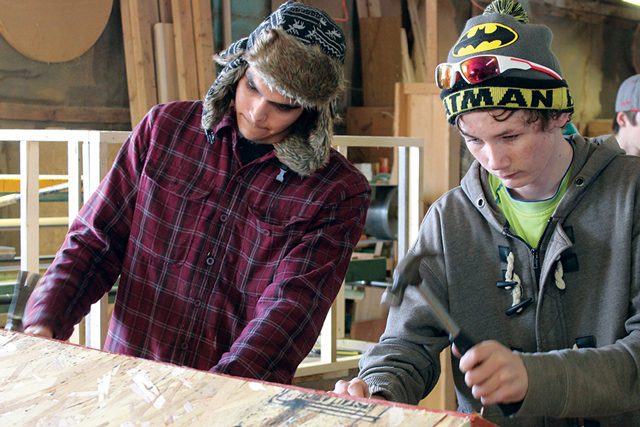Listen to this article
Listen to this article
Loading
Play
Pause
Options
0:00
-:--
1x
Playback Speed- 0.5
- 0.6
- 0.7
- 0.8
- 0.9
- 1
- 1.1
- 1.2
- 1.3
- 1.5
- 2
Audio Language
- English
- French
- German
- Italian
- Spanish
Open text
quakes roll through chile. salvation army sticks to its long-term response strategy. situated on the ring of fire, chile does not catch a break when it comes to earthquakes. according to earthquake today, the country has experienced more than 200 earthquakes in the past month alone and 500 in the past year. the recent magnitude-8.2 earthquake in the city of iquique—located in the north of chile—on april 1 was the strongest this year so far, killing six people and causing a tsunami of 7-foot waves according to reuters. the salvation army of the neighboring calama corps rushed on the scene to distribute water, milk, coffee and basic food supplies, and the iquique corps served soup to those affected. the chile central division launched a campaign for the response efforts. “people are very worried, especially in the coastal zones, about possible tidal waves; the idea of a tsunami terrorizes them because of the potential major damages that could happen in cities near the ocean,” said commissioner jorge ferreira, territorial commander for the south america west territory. with thousands of homes damaged and 30 boats—which many chilean fishermen depend on—destroyed, the salvation army assessed the damage, and as of april 8 plans were in place to send 20 tons of tents, blankets, mattresses and food to those in the affected areas, funded by the usa southern territory. emergency canteens were sent to worst-hit areas, but road damage hindered their progress. the territory is also looking to build basic wooden homes for people whose houses and belongings were destroyed. “the salvation army is taking every opportunity to offer primary help, but what really stood out was the strong presence of spirituality among the people,” ferreira said. “their trust in god gives strength and hope to those who have lost everything.”. this earthquake, however, is not the strongest in recent years. chile was struck by a magnitude-8.8 earthquake in 2010 and the subsequent tsunami killed over 500 people and the army today continues its long-term response to it. “the majority of construction work is built under earthquake resistant standards so there wasn’t a lot of destruction of homes in relation to the magnitude of the earthquake, but we were not prepared for a tsunami in the southern region,” said noelia pintos, territorial projects secretary for south america west. the salvation army and numerous volunteers worked in the zones of dichato, santa clara and caleta tumbes, which were the worst-hit locations in the tsunami as its residents’ simply constructed homes were extremely close to the ocean. “the losses in these communities were huge,” pintos said. “homes, boats—of which many fishermen depended on for income—and lives were lost.”. thanks to various donations from around the world, the salvation army was able to assist victims in the most direct and practical way possible for them. a knitting group, formed by 48 women ages 16 through 60, met every afternoon to cope with the aftermath day by day together. “it was a form of therapy for each of them,” pintos said. in caleta tumbes, the salvation army funded repairs and restoration of a facility in which women and their children met for recreational activities. “this place was very important to them because it served as a refuge from the rain and cold weather as they all shared time together,” pintos said. in addition to these community projects, fishermen in the affected areas approached the army for help. “after numerous visits and meetings with the local residents, we realized that the people did not want to keep receiving fish, but rather the fishing rods and lines to fish,” said pintos. the army was able to provide the fishermen boats with built-in security systems, tools for the local women to make their handicrafts with the seashells, and 20 freezers to store seafood to sell. an additional 32 families received wood burning stoves to cook their meals and heat their homes. pintos said, “today, these communities are generating their own resources like they were before the earthquake and tsunami thanks to the donations received and those who collaborated to help the salvation army in its response.”.
Open context player
Close context player
Plays:-Audio plays count
quakes roll through chile. salvation army sticks to its long-term response strategy. situated on the ring of fire, chile does not catch a break when it comes to earthquakes. according to earthquake today, the country has experienced more than 200 earthquakes in the past month alone and 500 in the past year. the recent magnitude-8.2 earthquake in the city of iquique—located in the north of chile—on april 1 was the strongest this year so far, killing six people and causing a tsunami of 7-foot waves according to reuters. the salvation army of the neighboring calama corps rushed on the scene to distribute water, milk, coffee and basic food supplies, and the iquique corps served soup to those affected. the chile central division launched a campaign for the response efforts. “people are very worried, especially in the coastal zones, about possible tidal waves; the idea of a tsunami terrorizes them because of the potential major damages that could happen in cities near the ocean,” said commissioner jorge ferreira, territorial commander for the south america west territory. with thousands of homes damaged and 30 boats—which many chilean fishermen depend on—destroyed, the salvation army assessed the damage, and as of april 8 plans were in place to send 20 tons of tents, blankets, mattresses and food to those in the affected areas, funded by the usa southern territory. emergency canteens were sent to worst-hit areas, but road damage hindered their progress. the territory is also looking to build basic wooden homes for people whose houses and belongings were destroyed. “the salvation army is taking every opportunity to offer primary help, but what really stood out was the strong presence of spirituality among the people,” ferreira said. “their trust in god gives strength and hope to those who have lost everything.”. this earthquake, however, is not the strongest in recent years. chile was struck by a magnitude-8.8 earthquake in 2010 and the subsequent tsunami killed over 500 people and the army today continues its long-term response to it. “the majority of construction work is built under earthquake resistant standards so there wasn’t a lot of destruction of homes in relation to the magnitude of the earthquake, but we were not prepared for a tsunami in the southern region,” said noelia pintos, territorial projects secretary for south america west. the salvation army and numerous volunteers worked in the zones of dichato, santa clara and caleta tumbes, which were the worst-hit locations in the tsunami as its residents’ simply constructed homes were extremely close to the ocean. “the losses in these communities were huge,” pintos said. “homes, boats—of which many fishermen depended on for income—and lives were lost.”. thanks to various donations from around the world, the salvation army was able to assist victims in the most direct and practical way possible for them. a knitting group, formed by 48 women ages 16 through 60, met every afternoon to cope with the aftermath day by day together. “it was a form of therapy for each of them,” pintos said. in caleta tumbes, the salvation army funded repairs and restoration of a facility in which women and their children met for recreational activities. “this place was very important to them because it served as a refuge from the rain and cold weather as they all shared time together,” pintos said. in addition to these community projects, fishermen in the affected areas approached the army for help. “after numerous visits and meetings with the local residents, we realized that the people did not want to keep receiving fish, but rather the fishing rods and lines to fish,” said pintos. the army was able to provide the fishermen boats with built-in security systems, tools for the local women to make their handicrafts with the seashells, and 20 freezers to store seafood to sell. an additional 32 families received wood burning stoves to cook their meals and heat their homes. pintos said, “today, these communities are generating their own resources like they were before the earthquake and tsunami thanks to the donations received and those who collaborated to help the salvation army in its response.”.
Listen to this article

















